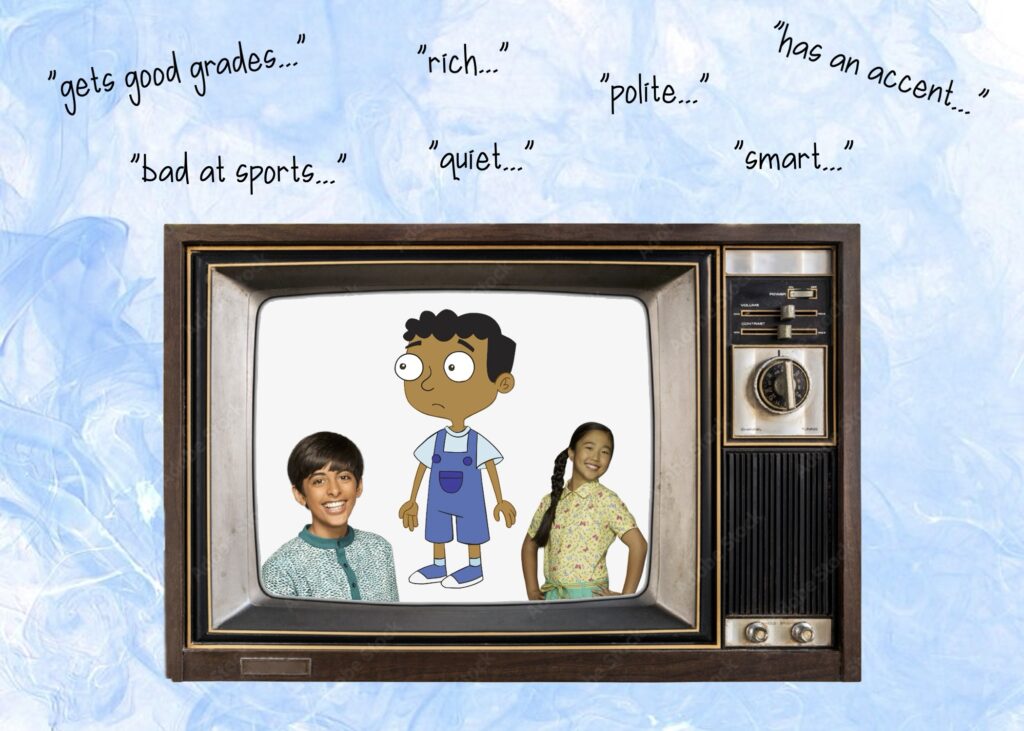
The average child in the U.S. watches 4.5 hours a day (CDC 2018)! With so much time spent watching television, how characters are portrayed shapes children’s behaviors and ideas (Dugan 2010, p. 998). From the age of 3, children are able to learn from video as well as live presentations (Moriguchi 2014, p. 3).
Yet children’s television continues to lack Asian representation: only about 12 percent of characters are Asian (Dobrow 2018). Even when Asian characters are included, they are typically portrayed in stereotypical ways, such as a model minority. Such portrayals depict Asians as naturally smart and successful because of their race (Museus 2009). They are also shown as socially awkward and subject to bullying (Ramasubramanian 2011). This is problematic because children might believe what they see on TV and think the reality is the same as the shows (Dugan 2010, p. 998).
Growing up, Phineas and Ferb was one of my favorite shows. I distinctly remember one main character, Baljeet because of how he was portrayed: He had a thick stereotypical Indian accent, was obsessed with his grades, and was bullied, exactly like stereotypes of the Asian model minority.
Similar to Baljeet, Ravi Ross from Disney Channel’s Jessie and the spin-off show, Bunk’d wears traditional clothing and is depicted as smart and unathletic, which he is made fun of for (Renazile-Winter 2022). He also has an Indian accent, which is not the actor, Karan Brar’s real accent. Additionally in Bunk’d, there is an East Asian character, Tiffany Chen who also wants to get good grades and go to a good college (Renazile-Winter 2022). This is pushed by her mother, who has high expectations of Tiffany, aligning with a stereotypical Asian “tiger mom”.
Many children who watch these TV shows may have not been exposed to people from different ethnicities. According to Cultivation Theory, watching large amounts of TV can cause people to see reality through the lens of the show (Gerbner 1976). This may be particularly the case when viewers are majority White, and have few personal interactions with Asians (Ramasubramanian 2011, p. 2). This is particularly an issue when Asian TV characters are portrayed reflecting the Model Minority because children believe the stereotypes, and might think that all Asians are smart and unathletic like Baljeet (Museus 2008, p. 3).
It is important that TV shows portray characters with a wide range of personalities, not just based on racial stereotypes, to prevent children from falsely assuming Asian stereotypes. More diverse representation and character development will expose children to people’s many idiosyncrasies irrespective of race and ethnicity, just like how they exist in our society. Such exposure can foster more open-mindedness (Chao 2015, p. 81).
References
Centers for Disease Control and Prevention 2018. “Screen Time vs. Lean Time.” Centers for Disease Control and Prevention. Retrieved March 7, 2024 (https://www.cdc.gov/nccdphp/dnpao/multimedia/infographics/getmoving.html#:~:text=About%20Screen%20Time,watching%20a%20screen%20for%20fun).
Chao, M. M., Kung, F. Y., & Yao, D. J. 2015. “Understanding the divergent effects of multicultural exposure.” International Journal of Intercultural Relations 47:78-88.
Dugan, T. E., Stevens, R., & Mehus, S. 2010. “From show, to room, to world: A cross-context investigation of how children learn from media programming.” Learning in the Disciplines: Proceedings of the 9th International Conference of the Learning Sciences 1 :992-999.
Gerbner, George and Larry Gross. 1976. “Living With Television: The Violence Profile.” Journal of Communication 26(2):172-199.
Moriguchi, Yusuke and Kazuo Hiraki. 2014. “Neural Basis of Learning From Television in Young Children.” Trends in Neuroscience and Education 3(3-4):122-127.
Museus, Samuel D. and Peter N. Kiang. 2009. “Deconstructing the Model Minority Myth and How It Contributes to the Invisible Minority Reality in Higher Education Research.” New Directions for Institutional Research 142:5-15.
Museus, Samuel D. 2008. “The Model Minority and the Inferior Minority Myths: Understanding Stereotypes and Their Implications for Student Learning.” About Campus 13(3): 2-8.
Ramasubramanian, Srividya. 2011. “Television Exposure, Model Minority Portrayals, and Asian-American Stereotypes: An Exploratory Study.” Journal of Intercultural Communication 11(2):1-12.
Renazile-Winter, Zoe Zulma. 2022. “Racial Stereotypes in Youth Media: How does the presence of racial stereotypes in popular TV Culture reflect the structure of society and negatively impact our youth?” Research Archive of Rising Scholars 1-12.
Dobrow, Julie, Clavin Gidney, and Jennier Burton. 2018. “Why It’s So Important For Kids to See Diverse TV and Movie Characters.” The Conversation. 7 March 2018. Retrieved 17, April 2024. (https://theconversation.com/why-its-so-important-for-kids-to-see-diverse-tv-and-movie characters-92576).